5. INTO THE "DARK AGES"

THE ROMAN CHURCH SURVIVES IN THE WEST
CONTENTS
 The Church survives: an overview The Church survives: an overview
 Patrick: Missionary to the Irish Patrick: Missionary to the Irish
 Noble Roman churchmen lay strong Noble Roman churchmen lay strong
foundations in the West
 The Christian (mostly Irish) missions to The Christian (mostly Irish) missions to
the Germanic tribal nations
The textual material on the page below is drawn directly from my work
A Moral History of Western Society © 2024, Volume One, pages 179-185.
|
A Timeline of Major Events during this period
432? Celestine sends Patrick to Ireland
after Palladius's failure
440 Pope Leo I (440-461) makes apostolic
claim to primacy ... through Peter's
having founded the church at Rome (the principle of "apostolic
succession")
500s Benedict of Nursia (early 500s)
writes the monks' Benedictine Rule
563 Irish evangelical Columba founds monastery at Iona
… starting the process of bringing Scotland to Christianity
Irish evangelical Columban (late 500s) goes to Gaul,
Switzerland and Italy
590s Pope Gregory I (590-604) organizes
church discipline and charity
But also negotiates a peace with the Lombards
597 Gregory sends Augustine to Kent
to bring Saxons to Trinitarian faith
634 Irish evangelical Aidan founds monastery at
Lindisfarne
663 The Synod of Whitby (663-664)
establishes papal (Roman Catholic) rule in Britain
Cuthbert soon changes Lindisfarne
from Irish evangelical to Roman Catholic
THE CHURCH
SURVIVES: AN OVERVIEW |
In
the West it was a very hard time. There was no reliable order in
the land, and road and sea travel became very dangerous. Trade and
industry ground to a halt. Urban life withered away to
nothing. Even the population dwindled rapidly in size.
People became dependent on a local tribal leader for protection – whose
fortified domain offered some small amount of protection against
wandering bands of trouble makers.
Politically, the city of Rome was now irrelevant, as what was left of
the Roman imperial order in the West was supervised now out of Ravenna,
in the north of Italy.
However, although Roman politics and economics collapsed under the
German conquests in the Western portions of the Empire – the Roman
religion, Catholic Christianity, did not. Indeed, Christianity
became the all important carrier in the West of what was left of Roman
civilization: in the social organization of the church, its bishops and
popes, and in its use of Latin in worship and study.
A number of Bishops of Rome (later termed “Popes”) – most notably Leo I
(pope: 440-461) and Gregory I (pope: 590-604) – managed to preserve and
strengthen what little remained of Roman or Latin moral-cultural order
in the West. Indeed, the church of Rome not only survived the
Germanic impact but converted some of the most important tribes to
Roman Christianity and
restored the city of Rome to a position of some degree of
religious-cultural importance – at least within the West itself.
Admittedly this was not very glamorous by comparison to what Rome once
was.
Closely connected with this survival of the Christian church was also
the monastic movement which at the time of the fall of Rome in the
early 400s was widespread. Numerous monks and priests at the
local level acquitted themselves fairly honorably along these same
moral-cultural lines, especially once the monastic movement had been
disciplined by Benedict (early 500s), whose rule was widely honored
throughout the West. Indeed, missionaries sent out by the Irish
monasteries (thanks to Patrick, who brought Christianity to Druid
Ireland in the early to mid-400s) helped to bring to the German (and
Celtic) tribesmen to the East of them in Great Britain and on the
European mainland important aspects of the Roman Latin Christian legacy
that otherwise would have been lost entirely to Western Europe.
|
PATRICK (389
- 461) MISSIONARY TO THE IRISH |
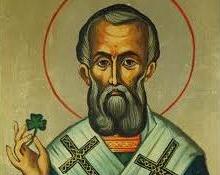 Patrick
served as amissionary to the Irish for some thirty years. It is
claimed that in that time he brought the nation to Trinitarian or
Catholic Christianity, establishing over 300 churches and baptizing
over 120 thousand Irishmen.1 Patrick
served as amissionary to the Irish for some thirty years. It is
claimed that in that time he brought the nation to Trinitarian or
Catholic Christianity, establishing over 300 churches and baptizing
over 120 thousand Irishmen.1
He was not himself Irish but British – developing a familiarity with
this isolated Celtic island when taken there as a young British slave
in 405. He escaped after about 6 years of hard and dangerous
service – and made his way back to his home in Britain, rejoining his
family, but shocked to find the land itself devastated by the Germans
during his absence in Ireland. He journeyed to southern France to
become a priest – and was serving there when God called him to return
to Ireland to bring that fierce Druid nation to Christ. But he
was passed over by Celestine, Bishop of Rome, recognized as the person
with the ultimate authority for such decisions. Celestine
appointed another priest to the task. But that mission was not
successful – and finally Celestine commissioned Patrick for the task.
This was a wise choice since Patrick was one who knew the Irish well,
and had an incredibly fearless heart. He well knew the power of
the Druid priests – and the importance of winning the respect of the
Irish chiefs. He also was aware of a ancient Irish prophecy well
known to all in Ireland that heralded the arrival of a small group of
foreigners attired and adorned almost exactly as he and his small group
of missionaries. He was ready to challenge the Druid priests (the
exact detailed have become so "expanded" in the retelling that it is
impossible to know what really happened). In any case he
succeeded in impressing the Irish chiefs – and was allowed to establish
himself in Armagh as the nation's first bishop.
From this key spiritual center he began to involve himself in the
political affairs of the nation – even intervening to protect Christian
Irish from raids by British Christians. But he was no less
involved in the social life of the country, establishing schools and
monasteries throughout the country to raise the level of learning of
the nation. Under his direction Irish monks began translating
works from the Greek and Hebrew and developing libraries of
considerable importance. But most of all he looked after the
spiritual needs of Ireland – leading the nation into a wholesale
embrace of Christianity.
The irony is that just as Roman Europe was undergoing a terrible
cultural eclipse caused by a general Germanic darkness – Ireland was
undergoing quite the opposite in the form of a true cultural
awakening. As the lights began to go out in the continental West,
in Ireland they began to burn – burn brightly.
Eventually it would be the Irish who would go forth as missionaries to
Germanic Europe – in an effort to restore Roman Catholic culture where
they could.
 For more on Patrick For more on Patrick
1What we know of Patrick comes from parts of his personal testimony, Confessio and also from his Letter to the soldiers of Coroticus.
We do not know exactly the dates of his birth or death however ...
although certainly he flourished in the mid-400s. His name
"Patrick" came from the Latin, Patricius ... perhaps derived from the
fact of his own British-Roman ancestry.
NOBLE ROMAN
CHURCHMEN LAY STRONG CHURCH FOUNDATIONS IN THE
WEST |
|
Leo I "the Great" (pope: 440-461)
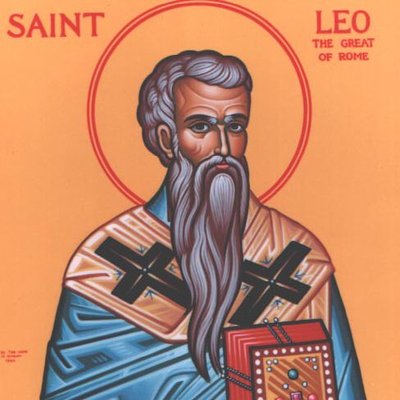 Leo
I, the bishop of Rome played the most important hand in tightening
church organization in the West at a time that Roman political order
was disintegrating there. During his tenure as Bishop of Rome he
became the unquestioned head of the Western church – that is,
"pope." The other bishops, especially the North African bishops,
simply declined in importance or even disappeared from view as the
German tribal leaders undercut the bishops" power bases. Leo
I, the bishop of Rome played the most important hand in tightening
church organization in the West at a time that Roman political order
was disintegrating there. During his tenure as Bishop of Rome he
became the unquestioned head of the Western church – that is,
"pope." The other bishops, especially the North African bishops,
simply declined in importance or even disappeared from view as the
German tribal leaders undercut the bishops" power bases.
Early on, Leo lined up the other bishops of Italy and North Africa
behind his lead in driving out of the church a number of heresies that
were drifting into the faith. Later, with the help of the Western
Emperor Valentinian III, he was able to draw a resistant church of Gaul
(France) under his authority. And when Attila and his Huns
threatened Rome it was Leo who met him and got him to withdraw his
troops, making him the primary political figure in Italy.
He was unabashed in his view that the Bishop of Rome was the head of
the church – not only in the West but in the church universal. He
based his claim on the logic of being of the apostolic line of
succession descending directly from Peter, the first Bishop of
Rome. His claim was not accepted in the East – though he
certainly was respected there. But his claim went unchallenged in
the West. From Leo's time on, the Bishop of Rome was acknowledged
in the West as the "pope," the head of the Roman Catholic Church.
|
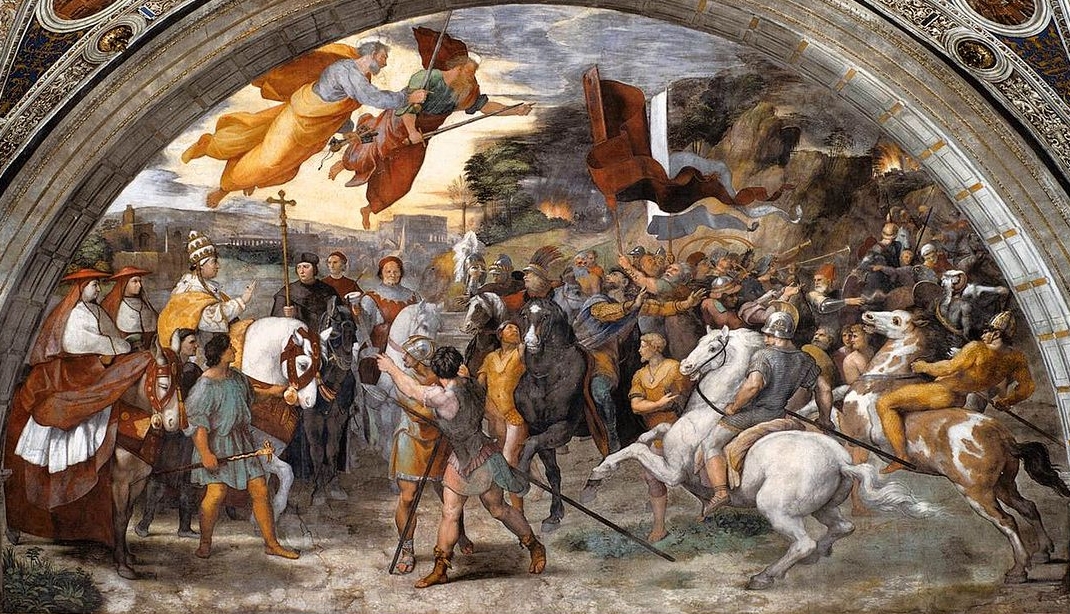
The meeting of Pope Leo and Attila - by Raphael
the Vatican
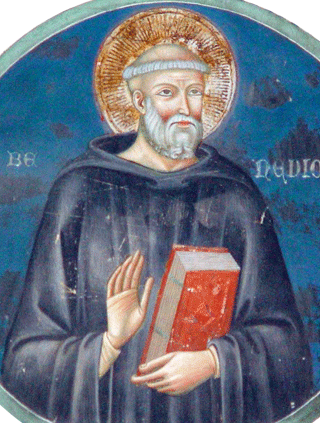 Benedict of Nursia (480-547) Benedict of Nursia (480-547)
In
the early 500s an Italian aristocrat-turned-monk, Benedict, founded
some fourteen monasteries (the first and most important at Monte Casino
in Southern Italy) and then laid out for the good order of these
monastic communities his Benedictine "Rule." This proved so
successful that it was widely copied among abbeys or monasteries
throughout the West. His Rule served to give form and strength to
the monastic movement. Indeed, over time, resulting from such
order and discipline, these monasteries themselves grew very rich.
Gregory I "the Great" (born: 540 / pope: 590-604)
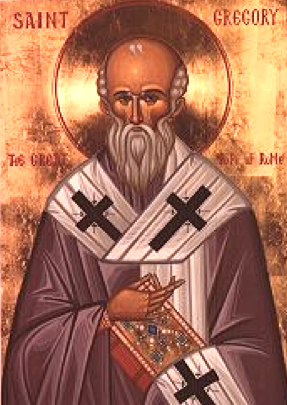 Gregory
was chiefly responsible for reorganizing the structure of the Western
Church – giving it the broad features that it would have for the rest
of the Middle Ages – and indeed, through the on going Roman Catholic
Church, even down to the present. Gregory was born of a noble or
"patrician" Roman family – a family possessing not only great wealth
but also a distinguished placement in the Christian community as a
family of deep Christian devotion. As a youth Gregory received
the typical patrician schooling at which he proved to be highly
accomplished. He eventually stepped into a public career (as
would have been expected of one with his family background) and by his
early 30s he had become the prefect of the city of Rome. Gregory
was chiefly responsible for reorganizing the structure of the Western
Church – giving it the broad features that it would have for the rest
of the Middle Ages – and indeed, through the on going Roman Catholic
Church, even down to the present. Gregory was born of a noble or
"patrician" Roman family – a family possessing not only great wealth
but also a distinguished placement in the Christian community as a
family of deep Christian devotion. As a youth Gregory received
the typical patrician schooling at which he proved to be highly
accomplished. He eventually stepped into a public career (as
would have been expected of one with his family background) and by his
early 30s he had become the prefect of the city of Rome.
But soon
thereafter he abandoned his public life and took up the vow of poverty
in becoming a monk. Eventually his family inheritance of
considerable landholding he turned to use as the site of a number of
monasteries. But Pope Pelagius II pressured him to come out of
seclusion and first had him appointed as a deacon of Rome and then as
papal ambassador to the Eastern Roman or Byzantine court in
Constantinople.
Here he revealed his highly organized mind in a
controversy he had with the Eastern Patriarch – a controversy in which
the Emperor eventually placed himself squarely on Gregory's side of the
argument. Eventually he was returned to Rome and soon became
abbot of St. Andrew's monastery – where he also became a widely
respected teacher of the Scriptures. But he became fascinated
with the idea of becoming a missionary to the Anglo Saxons of Britain –
but at the insistence of a very upset Roman populace was recalled to
Rome shortly after his departure. Under a promise never to leave
Rome, he soon became a special assistant to Pelagius II. But he
never lost his fascination for the idea of a mission to the Anglo
Saxons of Britain.
In 590, during the middle of a horrible plague which had followed upon
equally devastating floods, Pelagius II died – and the unanimous Roman
choice for pope went to Gregory – who nonetheless did what he could to
duck the responsibility. Nonetheless the Eastern Emperor
confirmed the appointment and Gregory was forced to take up the
position as bishop of Rome (pope).
Soon after his accession to the papacy, he began to demonstrate his
brilliance as a church administrator (including the management of the
vast land holdings of the church, which he used generously to support
the poor) – and as a dominating authority throughout the whole
Christian world. With respect to church organization, the
personal behavior of priests and bishops, and the handling of church
monies, he was deeply demanding of papal discipline throughout the
ranks of the church. He even claimed authority over the Patriarch
of Constantinople, insisting that the church at Rome was the true
Apostolic See.
He also drew the church into active politics – particularly when it
became evident that the Byzantine Emperor was not going to do anything
to stop the advancement of the Germanic Lombards across Italy.
Gregory not only appointed a new tribune to Naples to organize that
city's defenses against the Lombards but eventually entered directly
into negotiations with the Lombards for peace in Italy.
He finally had a chance to fulfill an old dream of sending a mission to
the Angles in Britain – sending Augustine of Canterbury to begin the
conversion of the Angles and Saxons in Britain. He also worked closely
with the monastic movement reformed by Benedict – by drawing
monasteries more closely into the ecclesiastical system that he
presided over and disciplining it according to his strict standards ...
and at the same time acting as a protector of the monasteries against
the efforts of bishops to bring these monasteries under their own
control.
|
THE CHRISTIAN
(MOSTLY IRISH) MISSIONS TO THE GERMANIC TRIBAL NATIONS |
The
monasteries (found significantly in unconquered Celtic Christian lands
in Ireland and Britain) became very important pockets of learning in
this dark Germanic world – sending out missionaries to the German
tribes, converting them to Catholic Christianity, planting new
monasteries in their midst and keeping the hope of a better world alive.
These monasteries were not under papal control – nor was there any real
"order" to them – but they provided a refuge for people who wanted to
devote themselves to God and serve their fellow man in charity
(something utterly lacking in the Roman Empire).
The most influential of these monastic havens within this darkened
Germanic world – perhaps because they were furthest removed from the
impact of the Germanic invasions – were the Irish monasteries started
up by Patrick. They not only kept the flame alive, but sent out
missionaries in the 500s and 600s to establish monasteries in the
Netherlands, France, Burgundy, Saxony, and Italy.
Columba (521-597)
Columba was a monk and missionary, known also by his Irish nickname,
Columcille (‘Dove of the church'). After his banishment from
Ireland for opposing the King he and 12 of his disciples founded in
Scotland the missionary settlement at Iona (563) – which became the
launch site for bringing Scotland into the Christian faith.
He had also been very active in shaping the Irish church in his earlier
years, founding several hundred churches and monasteries in Ireland as
well. And even after establishing himself in Iona he remained
active in Irish affairs, helping to shape the governmental structure of
Ireland at the council of Druim Cetta in 575.
Columban (c. 540-615)
Columban was another Irish monk who in 591 (at age 50+)
traveled with 12 of his disciples to the European continent, to the
Burgundian kingdom (in Southeastern Gaul or present day France) to
establish monasteries among the Celtic Gauls. But his strong
disapproval of the lax moral and spiritual conditions within the
Burgundian government and Roman church in that region brought him under
attack. In 610 (at age 70!) he was forced out of Burgundy.
He eventually settled in Switzerland to preach the faith to the pagan
Alamanni – though he was soon chased from this region as well because
of his having chopped down sacred pagan trees and because of a
continuing conspiracy against him in the courts of Theodoric II.
Thus he moved south into Italy (c. 612 614) and established a monastery
at Bobbio, where he died a short time later.
In his sermons, teachings, writings and personal example, he left a
legacy of spiritual integrity and vitality which gave inspiration to
Christians generations after him.
Augustine of Canterbury (? - c. 605)
Augustine was sent by Pope Gregory from Rome (where he had
been prior of a Benedictine abbey) to England to convert the Anglo
Saxons to Catholic Christianity. Augustine arrived in Kent in 597
accompanied by 40 monks. Kentish King Ethelbert was supportive of
Augustine's mission and gave him a place at Canterbury to base his
mission.
Augustine's mission proved to be highly successful. Ethelbert and
thousands of English were brought to the faith in the first year
alone. Within a few years a number of other missionaries were
sent to England to assist Augustine, including 12 bishops – over which
Augustine presided as archbishop. His church (Christ Church) was
recognized as the cathedral for England.
Aidan (?-651)
Aidan was a humble Irish monk at Iona, when he was
consecrated in 635 as bishop and sent to evangelize the English under
King Oswald (and King Oswin who succeeded Oswald in 642) in
Northumbria. Just off the Northumbrian coast, Aidan established
the mission center of Landisfarne for the training of more missionaries
to the English, including the brothers Chad and Cedd (missionaries to
the Mercians and East Saxons respectively) and Hilda (founder of a
number of monasteries, including the notable monastery of Whitby in
Northumbria, England).
The Synod of Whitby (663-664)
One of the growing questions of the day was whether these missions
ought to remain independent, or at least connected solely to the
sending authorities back in Ireland – or whether they ought to
affiliate themselves with the Bishop of Rome (the Pope). This was
both a cultural and political issue. Would they follow Celtic or
Roman patterns of church organization and life? Would they
preserve their autonomy or submit themselves to the Roman religious
order? Thus English Christians convened at Whitby to come to some
kind of a decision. Ultimately the decision was made in favor of
the Roman formula.
Cuthbert (634-687)
Cuthbert was profoundly spiritual and humble Celtic monk who entered
Melrose Abbey as a youth, became very close to its prior, Boisil, and
succeeded him in 661 after a plague killed Boisil. Cuthbert
quickly gained a reputation as a miracle worker after he went about the
countryside praying for and treating plague victims.
When after the decision of the Synod of Whitby to adopt Roman and drop
Celtic church traditions (a decision which Cuthbert supported) Colman,
who had been a leader of the Celtic position, resigned his post as
prior of Lindisfarne. Cuthbert was invited to take his
place. As prior of Lindisfarne, Cuthbert supervised the
changeover from the more informal Celtic to the much more highly
structured Roman church style.
But Cuthbert had more a heart for quiet piety than for administrative
duties. In 676, searching for solitude, he ventured to the Farne
Islands and established himself in a hermit's cell there.
However, his fame would not go away. He was recalled briefly as
prior of Lindisfarne and then once again retreated to the Farne Islands
where he lived out his days in prayer.
So well-loved was Cuthbert that the beautiful Lindisfarne Gospel
(a treasure today of the British Library!) was published by Bishop
Eadfrith of Lindisfarne in Cuthbert's honor shortly after his death.
|
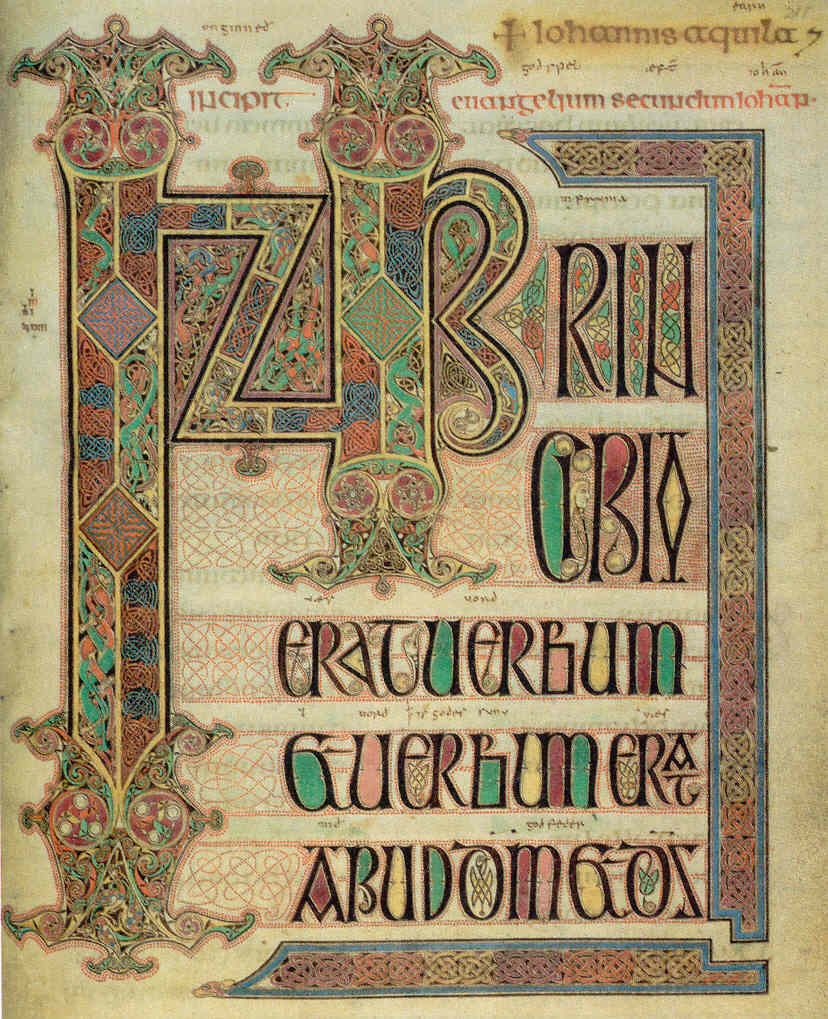
The Lindisfarne Gospel: The beginning of the Gospel of John – c. 698-700
The British Library
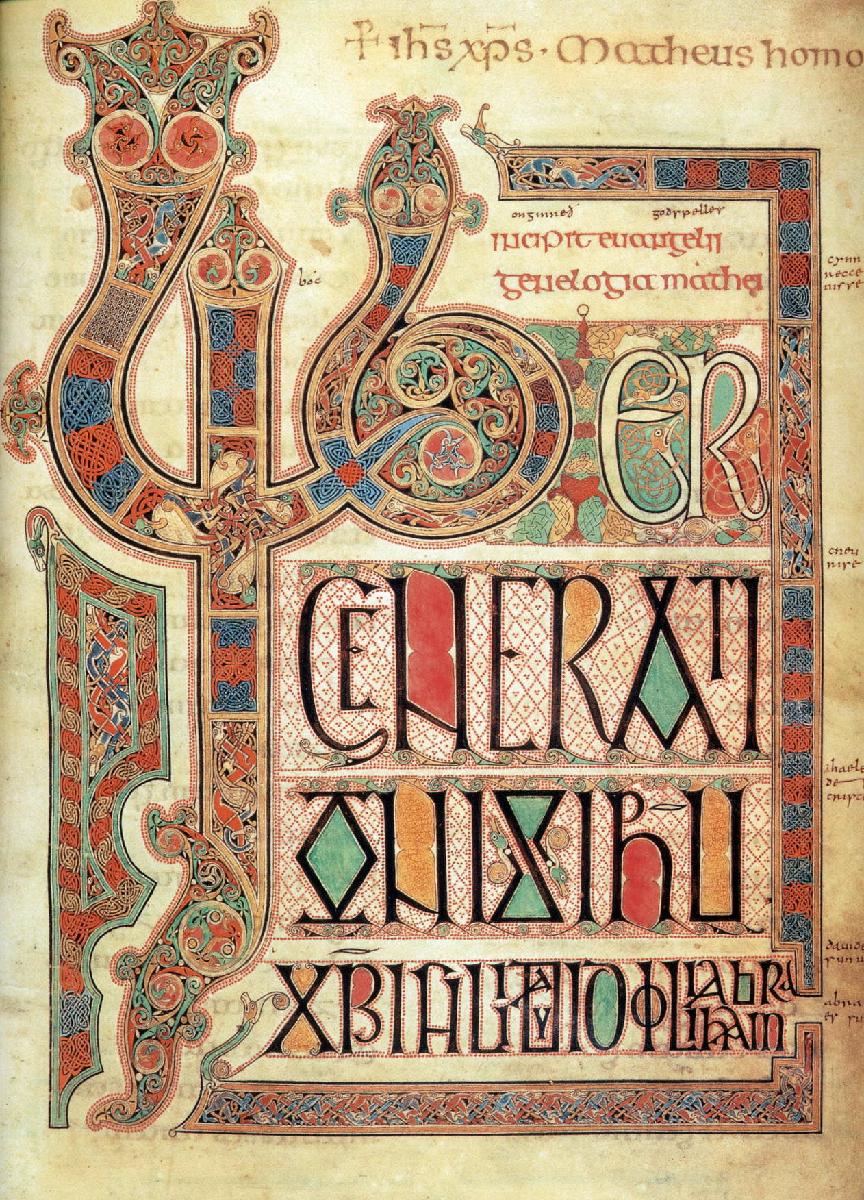
Page from the Lindisfarne Gospels
London, British Museum
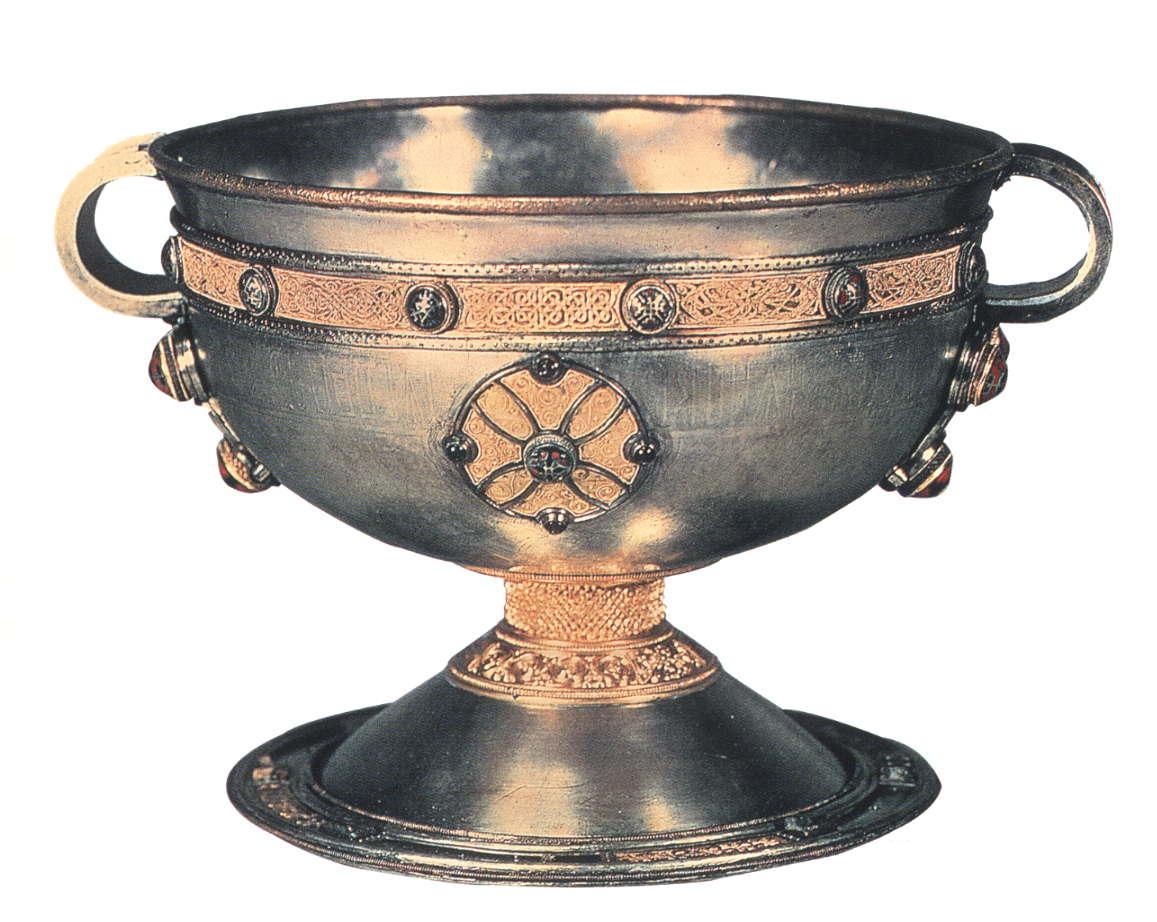
Silver and gold-plated bronze chalice from Ardagh (700s)
Dublin, National Museum of Ireland

Go on to the next section: Byzantine Rome
 Miles
H. Hodges Miles
H. Hodges
| | |


 The Church survives: an overview
The Church survives: an overview
 Patrick: Missionary to the Irish
Patrick: Missionary to the Irish
 Noble Roman churchmen lay strong
Noble Roman churchmen lay strong The Christian (mostly Irish) missions to
The Christian (mostly Irish) missions to









